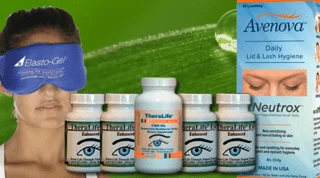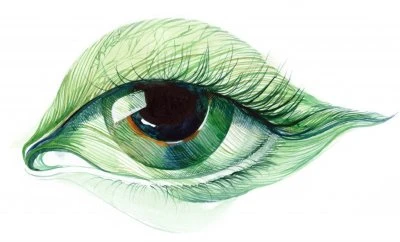Impact worldwide
Glaucoma is the leading cause of blindness around the world.
People with glaucoma are at higher risk of dry eye because the treatments can worsen the ocular surface and the tendency to cause dry eye. It is vital that when dry eye occurs, that all factors contributing to the development of dry eye are addressed as this may be enough to improve symptoms without needing to change treatment.
TheraLife is one such option where we treat dry eye without you needing to change glaucoma medications. TheraLife is all-natural. No steroids, no eye drops. To learn more, click here.
What Is It?
Inside, the eyeball is filled with a fluid called the aqueous humor. This fluid usually drains out through select channels. When this drainage no longer functions properly, the aqueous humor (fluid) remains, and pressure builds up in the eye. This is glaucoma.
The intraocular pressure (IOP) increases, causing permanent damage to the optic nerve. In later stages, a patient may begin to notice tunnel vision. Prolong glaucoma can lead to blindness.
Types
Primary open-angle glaucoma: This is by far the most common type. Open-angle glaucoma gradually develops as drainage deteriorates. It does not display symptoms of the damage until a significant portion of vision has been lost. Also known as chronic glaucoma, this type affects between three and four million people in theUnited States.
Angle-closure glaucoma: This happens when the drainage angle in the eye abruptly closes, causing a sudden increase in intraocular pressure. This pressure causes acute pain and vision loss and is a medical emergency. Although only one eye may suffer this acute attack, the other eye may also be at risk.
Secondary glaucoma: This damage is caused by diabetes, hypertension, eye injury, or the use of corticosteroids. Corticosteroids used to treat other eye problem is now more frequent than ever making secondary glaucoma a big problem.
Low-tension (normal-tension) glaucoma: In this type of glaucoma, the eye pressure is not elevated, but the optic nerve still becomes damaged. The cause is unknown.
Symptoms
Acute symptoms are much more likely to occur in Angle-closure glaucoma. Seek medical care help immediately if any of the following occur:
- Vision loss
- Eye pain
- Seeing a halo around a light
- Hazy look in the eye
- Tunnel vision (narrowed vision)
- Nausea or vomiting
Risk Factors
- Heredity – You are at higher risk if there is a family history of glaucoma
- Age – If you are over 60, you are at higher risk for the disease
- Injury – A history of eye trauma increases your risk
- Race – African Americans over age 40 are at a significantly higher risk for glaucoma
- Meds – Using prednisone, hydrocortisone, or cortisone increases your risk
- Other – Smoking and hypertension are believed to increase your risk
Diagnoses
Your eye doctor will perform a comprehensive eye examination, which will start with a patient and family history. In addition to any injuries, infections; vision problems; general health problems; plus a complete list of all medications and supplements you are taking.
Your eye doctor will determine which tests to perform based on the information you have provided but may perform several of the following:
- Tonometry (measures the pressure inside the eye)
- Visual acuity measurements (determines if vision is being affected)
- Pachymetry (measure corneal thickness; thinner corneas place you at increased risk)
- Perimetry (visual field testing, measures your central and peripheral vision)
- Retinal evaluation
- Other tests are based on the clinical findings from the above.
Treatment
Medication
Eye drops are generally the first treatment. Common types include:
- Prostaglandin analogs (work to increase fluid outflow from the eye, reducing the IOP)
- Beta-Blockers (decrease fluid production in the eye, lowering the IOP
Surgery
If drugs are not sufficient, or if the patient cannot tolerate them, surgery is another way to reduce the pressure in the eye. Procedures may include:
- Laser Trabeculoplasty (high energy laser beam unblocks clogged drainage structures)
- Filtering surgery (microsurgery forming a drainage flap)
- Drainage implants (insertion of a small tube to aid in drainage)
GLAUCOMA / DRY EYE TREATMENT
Glaucoma Treatment
Glaucoma is the term for when the pressure inside the eye rises high enough to damage the optic nerve. The condition often develops over many years without causing pain – so you may not experience vision loss until the disease has progressed.
Glaucoma cannot be prevented, and vision lost to it cannot be restored. Glaucoma left untreated can cause blindness. For these reasons, regular eye exams and early detection are critical.
The high eye pressure associated with glaucoma is most often caused by blockages in the eye’s fluid drains.
No one knows yet why the blockages form. Symptoms are usually not present but should be taken as warning signs that glaucoma may be developing. These include blurred vision, loss of peripheral vision, halo effects around lights, and painful or reddened eyes. People at the greatest risk include those who are over the age of 40, diabetic, near-sighted, African-American, or who have a family history of glaucoma.
Once diagnosed, glaucoma can often be controlled. Treatments to lower pressure in the eye include non-surgical methods such as prescription eye drops and medications, laser therapy, and surgery.
Dry Eye Treatments
Dry eyes can make a person’s eyes dry, red, or irritated. In addition to being uncomfortable, it can damage the eye’s tissues and impair vision. People usually begin experiencing dry eye symptoms as they age, but the condition can also result from eyelid or blinking problems, certain medications, environment, injury, and various health problems. The eyes may become dry and irritated because the tear ducts don’t produce enough tears or because the tears themselves have a chemical imbalance.
Dry eye is not preventable, but it can be controlled before harm is done to your eyes. Regular eye exams can detect dry eye early, even before symptoms become noticeable.
Non-surgical treatments include blinking exercises, increasing humidity at home or work, and artificial tears or moisturizing ointment. If these methods fail, small plugs may be inserted in the corners of the eyes to limit tear drainage, or the drainage tubes in the eyes may be surgically closed.
How TheraLIfe can help.
TheraLife has an oral dry eye treatment that is effective against dry eyes developed due to glaucoma treatment.
TheraLife’s proprietary formula revives and restores tear function for dry eye relief. No more drops.
For the comprehensive recovery package, click here

Glaucoma drops cause dry eyes. Stop dry eyes with the powerful TheraLife formula
Conclusion
While glaucoma itself does not cause dry eyes, the medication to treat glaucoma causes dry eyes always. Take care of your eyes with TheraLife.
References
- The ocular surface of glaucoma patients treated over the long term expresses inflammatory markers related to both T-helper 1 and T-helper 2 pathways.
Ophthalmology. 2008; 115: 109-115
- Prevalence of dry eye among an elderly Chinese population in Taiwan: the Shihpai Eye Study.
Ophthalmology. 2003; 110: 1096-1101
- Incidence of dry eye in an older population.
Arch Ophthalmol. 2004; 122: 369-373
- Prevalence of open-angle glaucoma among adults in the United States.
Arch Ophthalmol. 2004; 122: 532-538
- Prevalence of open-angle glaucoma and ocular hypertension in Latinos: the Los Angeles Latino Eye Study.
Ophthalmology. 2004; 111: 1439-1448
6. Steinbrook R. Searching for the right search—reaching the medical literature. N Engl J Med. 2006;354:4–7.
7. Jones TH, Hanney S, Buxton MJ. The journals of importance to UK clinicians: a questionnaire survey of surgeons. BMC Med Inform Decis Mak. 2006:6. Doi: 10.1186/1472-6947-6-24. – DOI
8. Schein M, Paladugu R, Sutija VG, et al. What American surgeons read: a survey of a thousand Fellows of the American College of Surgeons. Curr Surg. 2000;57:252–258.
9. Mcleod S. Ophtalmology aims [Ophthalmology Web site]. 2018. Available at: https://www.aaojournal.org/content/aims. Accessed October 31, 2019.
10. JAMA Ophthalmology Web site. Available at: https://jamanetwork.com/journals/jamaophthalmology/pages/for-authors. Accessed October 2, 2019.




